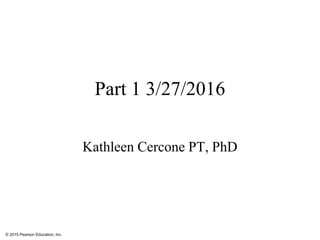Chapter10 part1 2016
- 1. ÂĐ 2015 Pearson Education, Inc. Part 1 3/27/2016 Kathleen Cercone PT, PhD
- 3. ÂĐ 2015 Pearson Education, Inc.
- 4. 4 3 Main aspects of a muscle contraction 1.Anatomy and micro anatomy 2.Neuromuscular connection for contraction to occur 3.Energy needed or nothing goes
- 5. 5 Special Characteristics of Muscle Tissue âĒExcitability, or irritability, is the ability to receive and respond to a stimulus. âĒ Contractility is the ability to contract forcibly when stimulated. âĒ Extensibility is the ability to be stretched. âĒ Elasticity is the ability to resume the cellsâ original length once stretched
- 6. ÂĐ 2015 Pearson Education, Inc.
- 7. ÂĐ 2015 Pearson Education, Inc.
- 8. ÂĐ 2015 Pearson Education, Inc.
- 9. ÂĐ 2015 Pearson Education, Inc.
- 10. ÂĐ 2015 Pearson Education, Inc.
- 11. ÂĐ 2015 Pearson Education, Inc. Myosatellite cell Immature muscle fiber Nuclei Myosatellite cell Up to 30 cm in length Mature skeletal muscle fiber The multinucleate cells begin differentiating into skeletal muscle fibers as they enlarge and begin producing the proteins involved in muscle contraction. Over time, most of the myoblasts fuse together to form larger multinucleate cells. However, a few myoblasts remain within the tissue as myosatellite cells, even in adults. Muscle fibers develop through the fusion of embryonic mesodermal cells called myoblasts. Myoblasts The development of a skeletal muscle fiber from myoblast to maturity Myoblasts fuse, forming cells Develop into skeletal muscle fibers Each skeletal muscle fiber nucleus represents a myoblast Not all myoblasts fuse into developing muscle fibers& Some remain in endomysium and help muscle repair
- 12. ÂĐ 2015 Pearson Education, Inc.
- 13. ÂĐ 2015 Pearson Education, Inc.
- 14. ÂĐ 2015 Pearson Education, Inc.
- 15. ÂĐ 2015 Pearson Education, Inc. Sarcoplasmic reticulum (SR) Ca2+ Gated calcium channel (closed) Calcium ion pump Sarcoplasm The membrane of the sarcoplasmic reticulum, which contains calcium ion pumps Transverse tubules (T tubules) T tubule encircling sarcomere at zone of overlap Sarcolemma Transverse tubule Terminal cisternae TriadPosition of M line
- 16. ÂĐ 2015 Pearson Education, Inc.
- 17. ÂĐ 2015 Pearson Education, Inc. The Organization of a Skeletal Muscle Fiber. T tubules Terminal cisterna Sarcoplasmic reticulum Triad Sarcolemma Mitochondria Thick filament MyofilamentsThin filament MYOFIBRIL The structure of a skeletal muscle fiber. SARCOMERE Z line Zone of overlap M line Myofibril I band H band A band Zone of overlap The organization of a sarcomere, part of a single myofibril. Z line M line Z line A stretched out sarcomere. Z line and thin filaments Active site Z line Actin molecules Thick filaments M line ACTIN STRAND Troponin Tropomyosin Thin filament MYOSIN MOLECULE Myosin tail Myosin head Hinge The structure of a thick filament. The structure of a thin filament.
- 18. 18
- 19. ÂĐ 2015 Pearson Education, Inc.
- 20. ÂĐ 2015 Pearson Education, Inc.
- 21. ÂĐ 2015 Pearson Education, Inc. The Organization of a Skeletal Muscle Fiber. Z line Zone of overlap M line Myofibril I band H band Zone of overlap A band SARCOMERE The organization of a sarcomere, part of a single myofibril.
- 22. ÂĐ 2015 Pearson Education, Inc. Z line Z line
- 23. ÂĐ 2015 Pearson Education, Inc. Sliding Filament Model of Contraction âĒ Thin filaments slide past the thick ones so that the actin and myosin filaments overlap to a greater degree âĒ In the relaxed state, thin and thick filaments overlap only slightly âĒ Upon stimulation, myosin heads bind to actin and sliding begins
- 24. ÂĐ 2015 Pearson Education, Inc. The Organization of a Skeletal Muscle Fiber. Z line M line Z line A stretched out sarcomere. Z line and thin filaments Z line Thick filaments M line
- 25. ÂĐ 2015 Pearson Education, Inc.

























